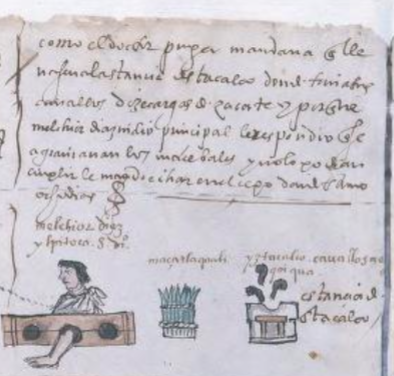mazatlacualli (Osu12v)
This iconographic example (practically a hieroglyph) comes from the Codex Osuna, folio 12 verso (or Image 27). It shows a bundle of grasses (glossed in Nahuatl, mazatlacualli) that were collected for the purpose of feeding horses at the estancia (stock-raising estate) of Doctor Vasco de Puga at Iztacalco. The blades of grass are vertical and pointed at the top. They are tied in two places with horizontal cords or ropes. As the contextualizing image shows, a Nahua man, Melchor Diez, who complained about the onerous, unpaid chore of collecting and delivering the grass, ended up being punished and put in stocks by Dr. Puga.
Stephanie Wood
From the first landing of horses on the shores of Mesoamerica, but especially once the colony was established, Spaniards began demanding grass to feed their animals. Since the horse was unknown to Nahuas, at first they called it a deer (mazatl). Soon, however, they took on the loan from Spanish, caballo (but spelled variously in Nahuatl). Still, fodder for horses retains the older sense, being literally “deer food.” Of course, deer also eat grass, and they were native to Mesoamerica. The usual Nahuatl term for the grass collected for feeding horses was zacatl (which became zacate in Spanish).
Stephanie Wood
1551–1565
Jeff Haskett-Wood
conflictos, crimen, mal trato, españoles, topiles, crimen, castigo, fodder, horses, grass, hierba, foraje

mazatlacual(li), food given to animals, https://nahuatl.wired-humanities.org/content/mazatlacualli
el foraje
Stephanie Wood
Library of Congress Online Catalog and the World Digital Library, Osuna Codex, or Painting of the Governor, Mayors, and Rulers of Mexico (Pintura del Gobernador, Alcaldes y Regidores de México), https://www.loc.gov/resource/gdcwdl.wdl_07324/. The original is located in the Biblioteca Nacional de España.
"The Library of Congress is unaware of any copyright or other restrictions in the World Digital Library Collection. Absent any such restrictions, these materials are free to use and reuse." But please cite the Biblioteca Nacional de España and this Visual Lexicon of Aztec Hieroglyphs if you use any of these images here or refer to the content on this page, providing the URL.





